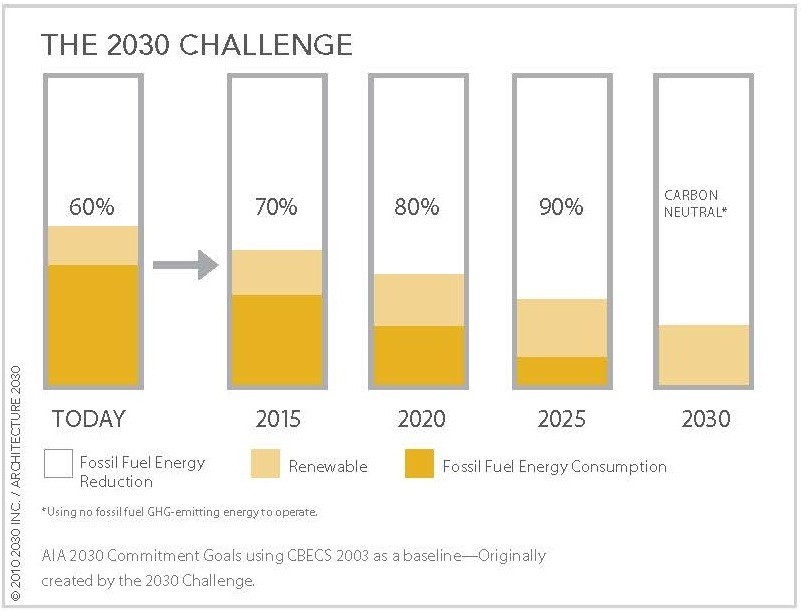This year marks the fifth anniversary of the American Institute of Architects’ effort to have architecture firms voluntarily pledge net-zero energy design for all their buildings by 2030. The AIA 2030 Commitment encourages design professionals to strategically reduce the measured energy consumption in new and existing buildings they design.
The 2030 Commitment is “an effort to get a firm’s complete body of work channeled toward carbon-neutral design,” says William D. Sturm, AIA, LEED AP, Principal at Serena Sturm Architects, Chicago, and Chair of the AIA National Committee on the Environment.
The pledge follows the 2030 Challenge issued in 2007 by Edward Mazria, FAIA, Founder and CEO of the nonprofit organization Architecture 2030, who called for the global building community to:
• Design all new buildings and major renovations to meet an energy consumption performance standard of 60% below the regional (or national) median for that building type.
• Renovate an equal amount of existing building area annually to meet an energy consumption performance standard of 60% below the regional (or national) median for that building type.
• Increase the fossil fuel reduction standard for all new buildings and major renovations in five-year increments, to reach carbon neutrality by 2030.
Last year, in its third annual 2030 Commitment progress report, the AIA called the program a roadmap for firms to transition to the ultimate goal of carbon neutrality on every project in their portfolio—not selectively targeting high performance for certain clients, or designing net-zero projects solely for clients who want it and can afford it, but achieving targeted performance goals on every project.
While there has been an increase in professional activity among medium and large firms, says Sturm, the 2030 goal may be out of reach for many smaller firms, which cite concerns over the amount of time and effort required to report on 2030 goals, as well as the lack of or access to data.
The AIA says that by the end of 2012, 241 firms had signed on to join the 2030 Commitment, with 110 of them submitting an annual progress report. These included such marquee names as CannonDesign, HOK, NBBJ, and Skidmore, Owings & Merrill, as well as midsize practices like Sturm’s own firm and Kaplan Thompson Architects, Portland, Maine.
A more recent summary on preliminary data from 2013 reporting presented at the AIA National Convention this past June showed 275 firms participating in the pledge; 79 of these had submitted data for 2013 on a total of more than 1.6 billion sf of work, reported Nootan Bharani, AIA, LEED AP BD+C, CEM, Lead Design Manager at the University of Chicago’s Place Lab, and Steve Kismohr, AIA, Senior Technical Manager at the Midwest Energy Efficiency Alliance.
The average predicted energy use intensity (EUI) reduction for 2013 from the 79 reporting firms was 34%, a slight increase from the average prediction for 2012. Around 7% of the gross square footage that was reported had reached the 2030 goal of 60% EUI reduction.
Sturm says that it is important for architecture firms to be prepared as more and more legislative bodies and standards organizations call for net-zero and carbon-neutral projects. Earlier this year California began implementing its revised building codes known collectively as Title 24, which call for all new residential and commercial construction in the state to achieve net-zero status by 2030.
Individual cities and institutions of higher learning have also embarked on 2030-type initiatives. The Royal Architectural Institute of Canada has issued a pledge to reduce greenhouse gas emissions in building construction and operation 70% by 2015, 80% by 2020, and 90% by 2025, to arrive at carbon neutrality by 2030.
William Leddy, FAIA, LEED AP, Founding Partner of Leddy Matum Stacy Architects in San Francisco and an Advisory Member of the AIA National Committee on the Environment, says “it just makes good business sense” for the architecture community to prepare for what he calls the “coming new realities” of the profession in the 21st century.
Related Stories
Urban Planning | Feb 5, 2024
Lessons learned from 70 years of building cities
As Sasaki looks back on 70 years of practice, we’re also looking to the future of cities. While we can’t predict what will be, we do know the needs of cities are as diverse as their scale, climate, economy, governance, and culture.
Products and Materials | Jan 31, 2024
Top building products for January 2024
BD+C Editors break down January's top 15 building products, from SloanStone Quartz Molded Sinks to InvisiWrap SA housewrap.
Airports | Jan 30, 2024
Rafael Viñoly Architects’ design for the new Florence, Italy, airport terminal will feature a rooftop vineyard
At Florence, Italy’s Aeroporto Amerigo Vespucci, the new international airport terminal will feature a fully operating vineyard on the facility’s rooftop. Designed by Rafael Viñoly Architects, the terminal is expected to see over 5.9 million passengers annually. Renderings for the project have recently been released.
Airports | Jan 15, 2024
How to keep airports functional during construction
Gensler's aviation experts share new ideas about how to make the airport construction process better moving forward.
Airports | Dec 4, 2023
4 key innovations and construction trends across airport design
Here are some of the key trends Skanska is seeing in the aviation sector, from congestion solutions to sustainability.
Giants 400 | Nov 13, 2023
Top 60 Airport Facility Construction Firms for 2023
Hensel Phelps, Turner Construction, AECOM, and Walsh Group top BD+C's ranking of the nation's largest airport terminal and airport facilities general contractors and construction management (CM) firms for 2023, as reported in the 2023 Giants 400 Report.
Giants 400 | Nov 13, 2023
Top 65 Airport Facility Engineering Firms for 2023
AECOM, Jacobs, Arup, Burns & McDonnell, and WSP head BD+C's ranking of the nation's largest airport terminal and airport facilities engineering and engineering architecture (EA) firms for 2023, as reported in the 2023 Giants 400 Report.
Giants 400 | Nov 13, 2023
Top 65 Airport Facility Architecture Firms for 2023
Gensler, Corgan, PGAL, and HOK top BD+C's ranking of the nation's largest airport terminal and airport facilities architecture and architecture engineering (AE) firms for 2023, as reported in the 2023 Giants 400 Report.
Building Materials | Oct 2, 2023
Purdue engineers develop intelligent architected materials
Purdue University civil engineers have developed innovative materials that can dissipate energy caused by various physical stresses without sustaining permanent damage.
Products and Materials | Sep 29, 2023
Top building products for September 2023
BD+C Editors break down 15 of the top building products this month, from smart light switches to glass wall systems.


















